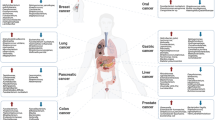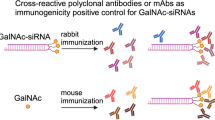Abstract
The A33 antigen is a cell surface glycoprotein of the small intestine and colonic epithelium with homology to tight junction-associated proteins of the immunoglobulin superfamily, including CAR and JAM. Its restricted tissue localization and high level of expression have led to its use as a target in colon cancer immunotherapy. Although the antigen is also present in normal intestine, radiolabeled antibodies against A33 are selectively retained by tumors in the gut as well as in metastatic lesions for as long as 6 weeks. Accordingly, we have studied the trafficking and kinetic properties of the antigen to determine its promise in two-step, pretargeted therapies. The localization, mobility, and persistence of the antigen were investigated, and this work has demonstrated that the antigen is both highly immobile and extremely persistent—retaining its surface localization for a turnover halflife of greater than 2 days. In order to explain these unusual properties, we explored the possibility that A33 is a component of the tight junction. The simple property of surface persistence, described here, may contribute to the prolonged retention of the clinically administered antibodies, and their uncommon ability to penetrate solid tumors.





Similar content being viewed by others
References
DeNardo GL (2005) Treatment of non-Hodgkin’s lymphoma (NHL) with radiolabeled antibodies (mAbs). Semin Nucl Med 35(3):202–211
Pagel JM, Hedin N, Subbiah K, Meyer D, Mallet R, Axworthy D, Theodore LJ, Wilbur DS, Matthews DC, Press OW (2003) Comparison of anti-CD20 and anti-CD45 antibodies for conventional and pretargeted radioimmunotherapy of B-cell lymphomas. Blood 101(6):2340–2348
Gruaz-Guyon A, Raguin O, Barbet J (2005) Recent advances in pretargeted radioimmunotherapy. Curr Med Chem 12(3):319–338
Boerman OC, van Schaijk FG, Oyen WJ, Corstens FH (2003) Pretargeted radioimmunotherapy of cancer: progress step by step. J Nucl Med 44(3):400–411
Johnstone CN, Tebbutt NC, Abud HE, White SJ, Stenvers KL, Hall NE, Cody SH, Whitehead RH, Catimel B, Nice EC, Burgess AW, Heath JK (2000) Characterization of mouse A33 antigen, a definitive marker for basolateral surfaces of intestinal epithelial cells. Am J Physiol Gastrointest Liver Physiol 279(3):G500–G510
Heath JK, White SJ, Johnstone CN, Catimel B, Simpson RJ, Moritz RL, Tu GF, Ji H, Whitehead RH, Groenen LC, Scott AM, Ritter G, Cohen L, Welt S, Old LJ, Nice EC, Burgess AW (1997) The human A33 antigen is a transmembrane glycoprotein and a novel member of the immunoglobulin superfamily. Proc Natl Acad Sci USA 94(2):469–474
Garin-Chesa P, Sakamoto J, Welt S, Real FX, Rettig WJ, Old LJ (1996) Organ-specific expression of the colon cancer antigen A33, a cell suface target for antibody-based therapy. Int J Oncol 9:465–471
Welt S, Divgi CR, Real FX, Yeh SD, Garin-Chesa P, Finstad CL, Sakamoto J, Cohen A, Sigurdson ER, Kemeny N et al (1990) Quantitative analysis of antibody localization in human metastatic colon cancer: a phase I study of monoclonal antibody A33. J Clin Oncol 8(11):1894–1906
Welt S, Divgi CR, Kemeny N, Finn RD, Scott AM, Graham M, Germain JS, Richards EC, Larson SM, Oettgen HF et al (1994) Phase I/II study of iodine 131-labeled monoclonal antibody A33 in patients with advanced colon cancer. J Clin Oncol 12(8):1561–1571
Welt S, Scott AM, Divgi CR, Kemeny NE, Finn RD, Daghighian F, Germain JS, Richards EC, Larson SM, Old LJ (1996) Phase I/II study of iodine 125-labeled monoclonal antibody A33 in patients with advanced colon cancer. J Clin Oncol 14(6):1787–1797
Welt S, Ritter G, Williams C Jr, Cohen LS, John M, Jungbluth A, Richards EA, Old LJ, Kemeny NE (2003) Phase I study of anticolon cancer humanized antibody A33. Clin Cancer Res 9(4):1338–1346
Scott AM, Lee FT, Jones R, Hopkins W, MacGregor D, Cebon JS, Hannah A, Chong G, Paul U, Papenfuss A, Rigopoulos A, Sturrock S, Murphy R, Wirth V, Murone C, Smyth FE, Knight S, Welt S, Ritter G, Richards E, Nice EC, Burgess AW, Old LJ (2005) A phase I trial of humanized monoclonal antibody A33 in patients with colorectal carcinoma: biodistribution, pharmacokinetics, and quantitative tumor uptake. Clin Cancer Res 11(13):4810–4817
Chong G, Lee FT, Hopkins W, Tebbutt N, Cebon JS, Mountain AJ, Chappell B, Papenfuss A, Schleyer P, Paul U, Murphy R, Wirth V, Smyth FE, Potasz N, Poon A, Davis ID, Saunder TJ, O’Keefe G, Burgess AW, Hoffman EW, Old LJ, Scott AM (2005) Phase I trial of 131I-huA33 in patients with advanced colorectal carcinoma. Clin Cancer Res 11(13):4818–4826
Ritter G, Cohen LS, Williams C Jr, Richards EC, Old LJ, Welt S (2001) Serological analysis of human anti-human antibody responses in colon cancer patients treated with repeated doses of humanized monoclonal antibody A33. Cancer Res 61(18):6851–6859
Johnstone CN, White SJ, Tebbutt NC, Clay FJ, Ernst M, Biggs WH, Viars CS, Czekay S, Arden KC, Heath JK (2002) Analysis of the regulation of the A33 antigen gene reveals intestine-specific mechanisms of gene expression. J Biol Chem 277(37):34531–34539
Chen CJ, Shively JE (2004) The cell–cell adhesion molecule carcinoembryonic antigen-related cellular adhesion molecule 1 inhibits IL-2 production and proliferation in human T cells by association with Src homology protein-1 and down-regulates IL-2 receptor. J Immunol 172(6):3544–3552
Ellenberg J, Siggia ED, Moreira JE, Smith CL, Presley JF, Worman HJ, Lippincott-Schwartz J (1997) Nuclear membrane dynamics and reassembly in living cells: targeting of an inner nuclear membrane protein in interphase and mitosis. J Cell Biol 138(6):1193–1206
Umenishi F, Verbavatz JM, Verkman AS (2000) cAMP regulated membrane diffusion of a green fluorescent protein-aquaporin 2 chimera. Biophys J 78(2):1024–1035
Partikian A, Olveczky B, Swaminathan R, Li Y, Verkman AS (1998) Rapid diffusion of green fluorescent protein in the mitochondrial matrix. J Cell Biol 140(4):821–829
Le TL, Yap AS, Stow JL (1999) Recycling of E-cadherin: a potential mechanism for regulating cadherin dynamics. J Cell Biol 146(1):219–232
Ji H, Moritz RL, Reid GE, Ritter G, Catimel B, Nice E, Heath JK, White SJ, Welt S, Old LJ, Burgess AW, Simpson RJ (1997) Electrophoretic analysis of the novel antigen for the gastrointestinal-specific monoclonal antibody, A33. Electrophoresis 18(3–4):614–621
Daghighian F, Barendswaard E, Welt S, Humm J, Scott A, Willingham MC, McGuffie E, Old LJ, Larson SM (1996) Enhancement of radiation dose to the nucleus by vesicular internalization of iodine-125-labeled A33 monoclonal antibody. J Nucl Med 37(6):1052–1057
Bruewer M, Utech M, Ivanov AI, Hopkins AM, Parkos CA, Nusrat A (2005) Interferon-gamma induces internalization of epithelial tight junction proteins via a macropinocytosis-like process. Faseb J 19(8):923–933
Kevil CG, Oshima T, Alexander B, Coe LL, Alexander JS (2000) H(2)O(2)-mediated permeability: role of MAPK and occludin. Am J Physiol Cell Physiol 279(1):C21–C30
Harhaj NS, Antonetti DA (2004) Regulation of tight junctions and loss of barrier function in pathophysiology. Int J Biochem Cell Biol 36(7):1206–1237
Musch MW, Walsh-Reitz MM, Chang EB (2006) Roles of ZO-1, occludin, and actin in oxidant-induced barrier disruption. Am J Physiol Gastrointest Liver Physiol 290(2):G222–G231
Ivanov AI, Nusrat A, Parkos CA (2004) Endocytosis of epithelial apical junctional proteins by a clathrin-mediated pathway into a unique storage compartment. Mol Biol Cell 15:176–188
Mandell KJ, Parkos CA (2005) The JAM family of proteins. Adv Drug Deliv Rev 57(6):857–867
Gray-Owen SD, Blumberg RS (2006) CEACAM1: contact-dependent control of immunity. Nat Rev Immunol 6(6):433–446
Kostrewa D, Brockhaus M, D’Arcy A, Dale GE, Nelboeck P, Schmid G, Mueller F, Bazzoni G, Dejana E, Bartfai T, Winkler FK, Hennig M (2001) X-ray structure of junctional adhesion molecule: structural basis for homophilic adhesion via a novel dimerization motif. Embo J 20(16):4391–4398
Brummendorf T, Lemmon V (2001) Immunoglobulin superfamily receptors: cis-interactions, intracellular adapters and alternative splicing regulate adhesion. Curr Opin Cell Biol 13(5):611–618
Walters RW, Freimuth P, Moninger TO, Ganske I, Zabner J, Welsh MJ (2002) Adenovirus fiber disrupts CAR-mediated intercellular adhesion allowing virus escape. Cell 110(6):789–799
Mullin JM, Agostino N, Rendon-Huerta E, Thornton JJ (2005) Keynote review: epithelial and endothelial barriers in human disease. Drug Discov Today 10(6):395–408
Sawada N, Murata M, Kikuchi K, Osanai M, Tobioka H, Kojima T, Chiba H (2003) Tight junctions and human diseases. Med Electron Microsc 36(3):147–156
Mullin JM (2004) Epithelial barriers, compartmentation, and cancer. Sci STKE 2004(216):pe2
Soler AP, Miller RD, Laughlin KV, Carp NZ, Klurfeld DM, Mullin JM (1999) Increased tight junctional permeability is associated with the development of colon cancer. Carcinogenesis 20(8):1425–1431
Ivanov AI, McCall IC, Babbin B, Samarin SN, Nusrat A, Parkos CA (2006) Microtubules regulate disassembly of epithelial apical junctions. BMC Cell Biol 7:12
Furuse M, Itoh M, Hirase T, Nagafuchi A, Yonemura S, Tsukita S, Tsukita S (1994) Direct association of occludin with ZO-1 and its possible involvement in the localization of occludin at tight junctions. J Cell Biol 127(6):1617–1626
Li Y, Fanning AS, Anderson JM, Lavie A (2005) Structure of the conserved cytoplasmic C-terminal domain of occludin: identification of the ZO-1 binding surface. J Mol Biol 352:151–164
Cliffe A, Mieszczanek J, Bienz M (2004) Intracellular shuttling of a Drosophila APC tumour suppressor homolog. BMC Cell Biology 5:37
Thomas T, Jordan K, Simek J, Shao Q, Jedeszko C, Walton P, Laird DW (2005) Mechanisms of Cx43 and Cx26 transport to the plasma membrane and gap junction regeneration. J Cell Sci 119:4451–4462
Kirshner J, Schumann D, Shively JE (2003) CEACAM1, a cell–cell adhesion molecule, directly associates with annexin II in a three-dimensional model of mammary morphogenesis. J Biol Chem 278(50):50338–50435
Schumann D, Chen CJ, Kaplan B, Shively JE (2001) Carcinoembryonic antigen cell adhesion molecule 1 directly associates with cytoskeleton proteins actin and tropomyosin. J Biol Chem 276(50):47421–47433
Hammarstrom S (1999) The carcinoembryonic antigen (CEA) family: structures, suggested functions and expression in normal and malignant tissues. Semin Cancer Biol 9(2):67–81
Chretien I, Marcuz A, Courtet M, Katevuo K, Vainio O, Heath JK, White SJ, Du Pasquier L (1998) CTX, a Xenopus thymocyte receptor, defines a molecular family conserved throughout vertebrates. Eur J Immunol 28(12):4094–4104
Bazzoni G (2003) The JAM family of junctional adhesion molecules. Curr Opin Cell Biol 15(5):525–530
Kuespert K, Pils S, Hauck CR (2006) CEACAMs: their role in physiology and pathophysiology. Curr Opin Cell Biol 18:565–571
van Osdol W, Fujimori K, Weinstein JN (1991) An analysis of monoclonal antibody distribution in microscopic tumor nodules: consequences of a “binding site barrier”. Cancer Res 51(18):4776–4784
Saga T, Neumann RD, Heya T, Sato J, Kinuya S, Le N, Paik CH, Weinstein JN (1995) Targeting cancer micrometastases with monoclonal antibodies: a binding-site barrier. Proc Natl Acad Sci USA 92(19):8999–9003
Graff CP, Wittrup KD (2003) Theoretical analysis of antibody targeting of tumor spheroids: importance of dosage for penetration, and affinity for retention. Cancer Res 63(6):1288–1296
Thurber GM, Zajic SC, Wittrup KD (2007) Theoretic criteria for antibody penetration into solid tumors and micrometastases. J Nucl Med 48(6):995–999
Acknowledgments
The authors wish to kindly acknowledge funding by NCI CA101830, and the receipt of antibodies and cell lines from the Ludwig Institute and from Dr. John Shively at City of Hope.
Author information
Authors and Affiliations
Corresponding author
Rights and permissions
About this article
Cite this article
Ackerman, M.E., Chalouni, C., Schmidt, M.M. et al. A33 antigen displays persistent surface expression. Cancer Immunol Immunother 57, 1017–1027 (2008). https://doi.org/10.1007/s00262-007-0433-x
Received:
Accepted:
Published:
Issue Date:
DOI: https://doi.org/10.1007/s00262-007-0433-x




